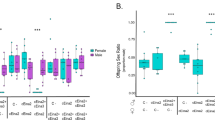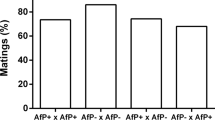Abstract
THE cytoplasmically inherited microorganism Wolbachia pipientis behaves like a sexually selected trait in its host, the flour beetle Tribolium confusum, enhancing male fertility at the expense of female fecundity. Here we show that infected females have fewer offspring than uninfected females but infected males have a large fertility advantage over uninfected males within multiply-inseminated infected or uninfected females. The male fertility effect accelerates the spread of the Wolbachia through the host population and expands the initial opportunity for hitch-hiking of host nuclear genes. Sperm competition in a host, mediated by endosym-bionts, has not been previously described.
This is a preview of subscription content, access via your institution
Access options
Subscribe to this journal
Receive 51 print issues and online access
$199.00 per year
only $3.90 per issue
Buy this article
- Purchase on Springer Link
- Instant access to full article PDF
Prices may be subject to local taxes which are calculated during checkout
Similar content being viewed by others
References
Woese, C. R. Microbiol. Rev. 51, 221–271 (1987).
Yang, D., Oyaizu, Y., Oyaizu, H., Olsen, G. J. & Woese, C. R. Proc. natn. Acad. Sci. U.S.A. 82, 4443–4447 (1985).
O'Neill, S. L., Giordano, R., Colbert, A. M. E., Karr, T. L. & Robertson, H. M. Proc. natn. Acad. Sci. U.S.A. 89, 2649–2702 (1992).
Breewuer, J. A. J. et al. Insect molec. Biol. 1, 25–36 (1992).
Stouthamer, R., Breewuer, J. A. J., Luck, R. F., Werren, J. H. Nature 361, 66–68 (1993).
Wade, M. J. & Stevens, L. Science 227, 527–528 (1985).
Stevens, L. & Wade, M. J. Genetics 124, 367–372 (1990).
Stevens, L. Anim. Behav. 46, 305–310 (1993).
Kambhampati, S., Rai, K. S. & Burgun, S. J. Evolution 47, 673–677 (1993).
Hoffmann, A. A. & Turelli, M. Genetics 119, 435–444 (1988).
Turelli, M. & Hoffmann, A. A. Nature 353, 440–442 (1991).
Turelli, M., Hoffmann, A. A. & McKechnie, S. W. Genetics 132, 713–723 (1992).
Breewuer, J. A. J. & Werren, J. H. Nature 346, 558–560 (1990).
Montchamp-Moreau, C., Feveur, J. & Jacques, M. Genetics 129, 399–407 (1991).
O'Neill, S. L. & Karr, T. L. Nature 348, 178–180 (1990).
Rousset, F. & Raymond, M. Trends Ecol. Evol. 6, 54–57 (1991).
Wade, M. J. & Stevens, L. J. theor. Biol. 167, 81–88 (1994).
Moran, N. & Baumann, P. Trends Ecol. Evol. 9, 15–20 (1994).
Holden, P. R., Jones, P. & Brookfield, J. F. Y. Genet. Res. 62, 23–29 (1993).
Rousset, F. & De Stordeur, E. Heredity 72, 325–331 (1993).
Trpis, M. J., Perrone, J. B., Reissig, M. & Parker, K. L. J. Heredity 72, 313–317 (1993).
Subbarao, S. K. in Recent Developments in the Genetics of Insect Disease Vectors (eds Steiner, W. W. M., Tabachnick, W. J., Rai, K. S. & Narang, S.) 313–342 (Stipes, Champaign, Illinois).
Thompson, J. N. Biol. J. Linn. Soc. 32, 385–393 (1987).
Richardson, P. M., Holmes, W. P. & Saul II, G. B. J. Invert. Path. 50, 176–183 (1987).
Park, T. J. exp. Zool. 65, 17–42 (1933).
Wade, M. J., Patterson, H., Chang, N. W. & Johnson, N. A. Heredity 72, 163–167 (1994).
Robinson, T., Johnson, N. A. & Wade, M. J. Heredity 73, 155–159 (1994).
Lande, R. Proc. natn. Acad. Sci. U.S.A. 78, 3721–3725 (1981).
Author information
Authors and Affiliations
Rights and permissions
About this article
Cite this article
Wade, M., Chang, N. Increased male fertility in Tribolium confusum beetles after infection with the intracellular parasite Wolbachia. Nature 373, 72–74 (1995). https://doi.org/10.1038/373072a0
Received:
Accepted:
Issue Date:
DOI: https://doi.org/10.1038/373072a0
This article is cited by
-
Novel bacteriocyte-associated pleomorphic symbiont of the grain pest beetle Rhyzopertha dominica (Coleoptera: Bostrichidae)
Zoological Letters (2017)
-
Three-way interaction among plants, bacteria, and coleopteran insects
Planta (2016)
-
Interactions between the sexes: new perspectives on sexual selection and reproductive isolation
Evolutionary Ecology (2009)
-
Selfish genetic elements and sexual selection: their impact on male fertility
Genetica (2008)
-
Selfish genetic elements and sexual selection: their impact on male fertility
Genetica (2008)
Comments
By submitting a comment you agree to abide by our Terms and Community Guidelines. If you find something abusive or that does not comply with our terms or guidelines please flag it as inappropriate.



